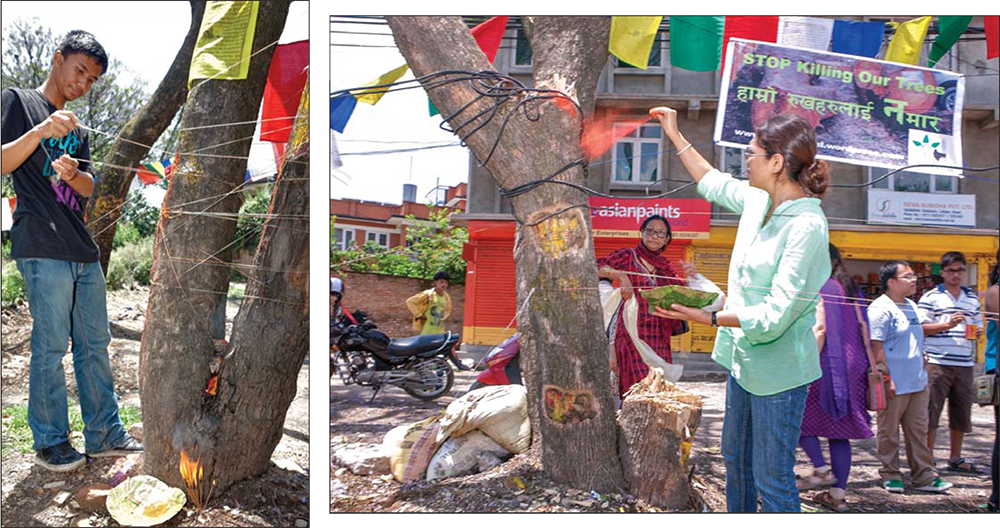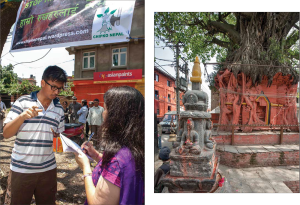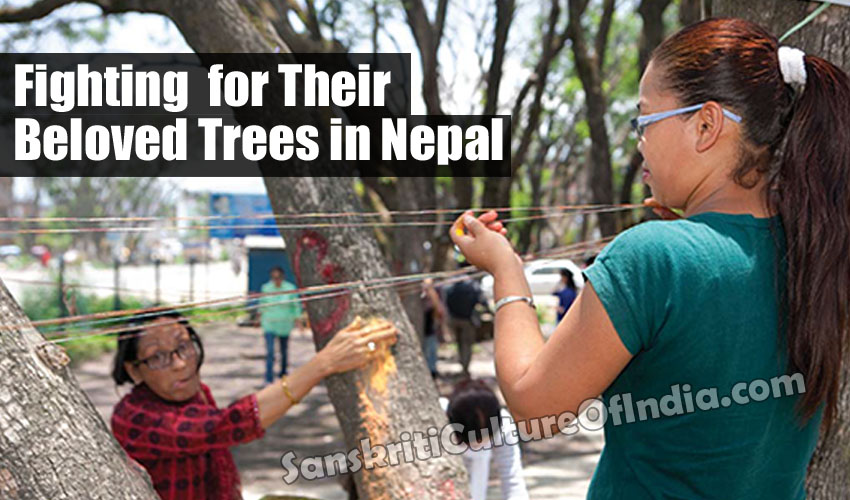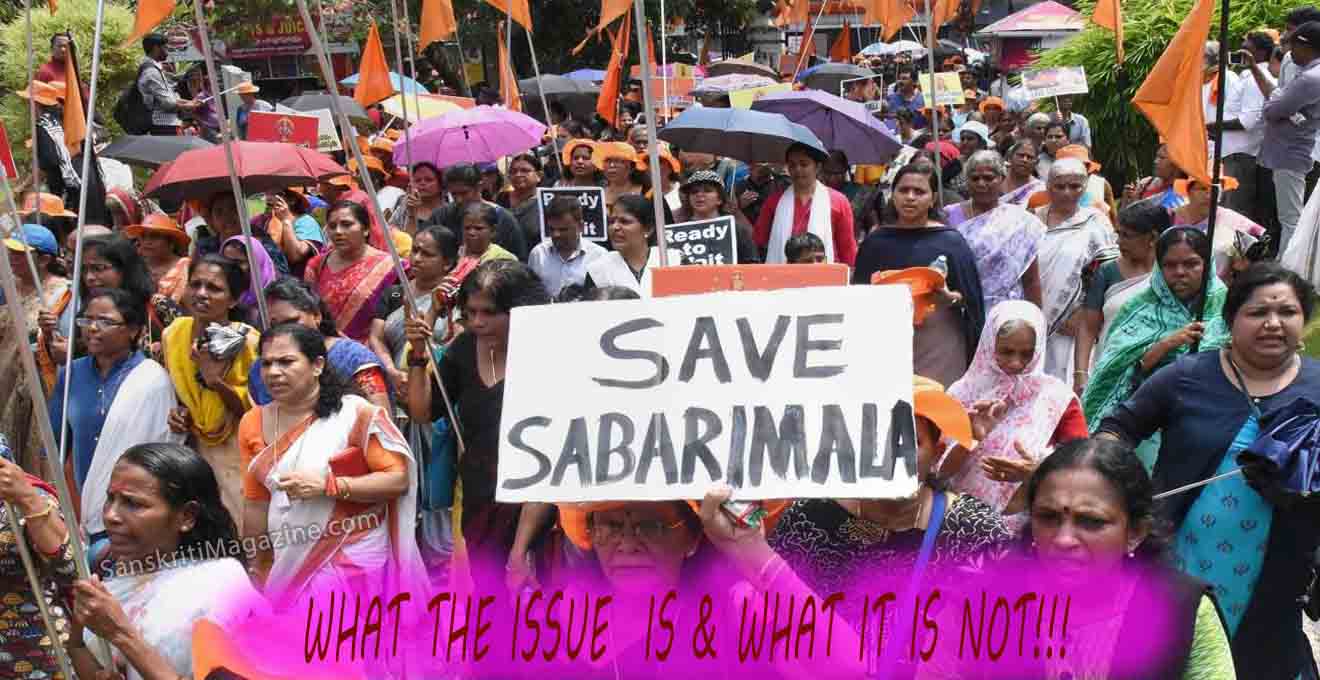THE TREES FALLING TO CHAINSAWS along Kathmandu’s roads are old and stately, but the protesters’ tools are thousands of years older: sacred thread, vermillion powder and flowers.
Residents and others are alarmed because thousands of huge old trees are being cut down in two major and simultaneous road improvement projects and—despite promises—none is being replanted. The expansion of the Ring Road is planned and funded by China, while roads inside the city are being widened in a separate project of the Nepali government based on a plan from the 1970s.
The Ring Road itself was built in the 1970s, and in an example of successful environmental abatement the Chinese planted many roadside shade trees which grew tall and magnificent in their maturity. These days, though, the Ring Road is clogged with traffic. China is granting Nepal roughly $6.7 million (547 million Nepali rupees) to expand it, on condition that a Chinese contractor be used. The planning was done by a Chinese team. Alarmingly, sketches in the Road Department office indicate no trees or greenbelt.
Adding to residents’ alarm is the ongoing digging, tree-cutting and wall-breaking that has filled the city with debris as part of another road improvement plan, the Urban Development Implementation Act of 1977. This ambitious, massive plan to broaden the roads and reduce traffic bottlenecks, long delayed due to the reluctance of previous governments, was finally set into motion by the Maoist-led administration of Baburam Bhattarai, who left office in March. The work is continuing under the interim government.
But over the intervening decades, many residents unknowingly built shops and homes on lands the Act had earmarked for road work. The ditches and mounds that Kathmandu residents have been stepping around for months are filled with rubble from these shops and homes. In many cases homeowners have demolished and rebuilt their own walls rather than waiting for the road crews. Whole lines of shops and homes have pulled back from the streets, their exterior walls destroyed and rebuilt. Temples have been moved after suitable pujas. Trees can’t shrink back from the expanding asphalt, so they’ve simply been chopped down.
Plea for Eco-Sensitive Development
Few question the need for better roads in congested Kathmandu, with its narrow lanes and helter-skelter development. But many are skeptical of the planning for the projects, fearing there will soon be little greenery left in this city, where smog hides the Himalayas and people have taken to wearing face masks because of rampant pollution
.

So the Nepalese are trying to stop the bulldozers with sacred thread. Many of Kathmandu’s trees are now blessed with sindoor, circled with thread and painted with messages as activists urge respect for what they see as two aligned ideals: the traditional sense of sacred nature and contemporary eco-sensitive development.
“Save Me,” says a message scrawled on a massive tree whose branches shade a chautari, or seating place, between a vegetable market and an area known as Tibetan Camp. Bulldozers have carved up the road around it, turning the local hangout into an island in the mud but leaving the thread-encircled giant alone for now.
“Save Me,” plead the words scrawled on trees along the Ring Road, some of the 1,239 trees marked for destruction along the southern arc of the city’s 17-mile beltway. Protesters are asking for a halt until they see a plan that makes an effort to save those trees that can be saved, ensures walkways and bicycle lanes, and follows legal and traditional precepts for planting more trees than are cut.
“It’s always been said it’s a sin to cut trees,” said Sampurna Basnet, a college student at a recent protest where environmentalists arrived with powder-filled tapari (bowls made of leaves) and Buddhist prayer flags.
“Birds are messengers of the Gods. Why would we take away their homes?” asked artist Milan Rai, who has been placing paper butterflies on endangered trees in a message of hope for positive transformation. “When people cut trees, they always used to plant more. We’ve always been nature worshipers. Now everybody is forgetting the connection. In the name of development, we’re becoming self-destructive.”
Over the past few months hundreds of young people have marched repeatedly to the Road Department bearing saplings, pledging to nurture them and asking the government to do the same for Kathmandu’s existing trees. They’ve also built a model bicycle path, using gravel and their own labor, to demonstrate their vision of positive development. It’s an intentionally peaceful and nonpartisan gesture in this often strike-crippled and politicized city, where the movement to save the trees has been unusual in many ways, not the least of which has been chants such as, “Are we part of an organization? No!”
Urging Respect for Nepal’s Heritage
One common thread in this informal, often Facebook-driven effort has been a vision of development that doesn’t repeat the mistakes of other countries but modernizes in a way that respects the environment and Nepal’s heritage.

In Nepali culture, planting trees and creating chautari where people can rest under the shade has long been a way to earn merit. The Vedas are full of invocations to the earth (bhu), atmosphere (bhuvah), sky (sva) and the primordial forces of nature. Sacred trees and plants are numerous; and while certain trees are particularly sacred, such as the spreading banyan and peepal trees, all trees are recognized as valuable and connected with Vishnu, the Preserver. Watering trees is seen as a spiritual duty, and those who cut down trees must plant more.
In some villages trees are worshiped in the month of Baisakh (April-May) with the creation of temporary temples under a tree to ask for rain. The people say that if trees are cut, the rains won’t come. In recent decades chautari have been leveled for roads all across the country, with little effort to save the old trees that once formed the heart of village life. This, while, Nepal’s news and even its school textbooks are packed with information on global warming and the importance of saving the environment. Protesters cite the irony of so many trees being cut in a capital city that is full of donor agencies, embassies and policy makers who urge Nepalis to become environmentally aware.
“What do we study in school?” twelfth grader Bijeta Bhandari asked a crowd at a recent rally. “The environment! Does the government have us study it because it’s important? Yes! Then what kind of example is this?”
The effort to save the trees began quietly last year as a beloved line of old trees near the zoo fell to chainsaws and roadwork approached a nearby khari tree that serves as a neighborhood landmark. Many Kathmandu neighborhoods, though tight-packed and urbanized, have their own giant trees where elders chat in the shade and youth clubs gather for sports. Some are sacred pipal and banyan trees; some are not. But they’re part of the urban landscape of Greater Kathmandu, along with the jacaranda that bloom purple in the spring and the tall trees that soften the dust-and-concrete grimness of the Ring Road.
“What I really love about those trees is that they have so many functions,” says Lucia deVries, a 21-year Nepal resident who lives near the Ring Road and helped organize the earliest protests. “They’re community parks. Shops are based under the trees—the tailors, the fruit sellers—and there are always boys playing football and table tennis. If you go to a place with no trees, people aren’t hanging out. Stretches with no trees are like barren places. They’re ugly.”
Questions about Health and Livability
Controversies rage. The government has been accused of ignoring private property rights, questions have been raised about who benefits financially from wood sold after chopping trees, and the dust in the air from demolition is linked to an increase in asthma and respiratory ailments. But many also admire the government’s ability to muster the political will after so many decades of inaction on the roads. And there’s little criticism of the ultimate goal: clearer, wider, less dusty streets. The protesters agree with that, too. The question is how to go about it and what a livable city would look like in the long run.“We don’t want development that’s all about concrete and overpasses. That’s not our definition of development. We need ways for small children and grandmothers to walk and ride bicycles,” said protester Sail Shrestha. “All around the world, people are saying, ‘Oh no, we made a mistake here.’ They’re trying to come back to be like Nepal was. We shouldn’t follow their mistakes.”
Government Promises to Plant
Ashok Tiwari, who heads up both projects in the Lalitpur area, says his Road Department will replant four trees for each tree cut. It’s a Hindu tradition long enshrined by law in Nepal, although Tiwari says the law only applies these days to forest land and the Road Department isn’t legally required to replant.After a day in which he got so many messages on his cell phone that “I couldn’t even breathe,” Tiwari said he spoke to the Chinese contractors and they agreed to mark the route publicly so citizens would know which trees are to be cut. That would also theoretically prevent illegal cutting of other trees in the name of roadwork. But as of this writing that has not happened, even though its commencement has been announced.Inside the city, too, Tiwari promises that trees will be replaced eventually, although the pavement has already been laid. “We can tear up the pavement stones. It’s just sand under there. It’s not hard,” he says.
Planting New Trees Just Makes Sense
But after a year in which many neighborhoods have seen trees cut and no replanting, and in the general atmosphere of skepticism about government pledges and dismay about the charmless concrete that is spreading in the historic city, the protesters want more than words. They recently marched to the Chinese Embassy to ask its support in ensuring that the Shanghai contractors deliver a more walkable, contemporary, eco-friendly city design. After all, noted DeVries, it was China who initially funded the planting of many of the popular Ring Road trees. “They did such a great job then,” she says. “That’s the approach we need to see now.”Many feel this approach would preserve cultural and spiritual values as well as the environment. “We need so many things from trees throughout our lives,” says 11th-grader Lirona Joshi. “With our first breath, we take their oxygen. We need their leaves for ceremonies, and when we die, we need their wood to be burned. Our elders planted trees, but now, instead of planting trees, we are cutting them. That is senseless.”
Older people sympathize with the protesters. Govinda Bahadur Karki, who spent 12 years in the Middle East, said the protesters have a better sense of real “development” and “modernization” than the tree cutters. “It doesn’t save money to cut trees,” he said. “If we go to the hospital because we’re breathing polluted air, don’t we have to pay money?”
Trees are good for business, added Gehendra Raj Koirala. Shops do more business when people come to enjoy the nearby shade. “We need development, and if a tree is really in the way of the road, it must be cut. But we need to save as many as we can. And we need to replant as we did in the past—big trees, not saplings. It takes many years for trees to get this big. If our generation cuts the trees, what will they think of us in the future?”
~BY SALLY ACHARYA, KATHMANDU











